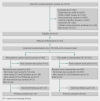Effectiveness of enhanced communication therapy in the first four months after stroke for aphasia and dysarthria: a randomised controlled trial
- PMID: 22797843
- PMCID: PMC3396461
- DOI: 10.1136/bmj.e4407
Effectiveness of enhanced communication therapy in the first four months after stroke for aphasia and dysarthria: a randomised controlled trial
Abstract
Objective: To assess the effectiveness of enhanced communication therapy in the first four months after stroke compared with an attention control (unstructured social contact).
Design: Externally randomised, pragmatic, parallel, superiority trial with blinded outcome assessment.
Setting: Twelve UK hospital and community stroke services.
Participants: 170 adults (mean age 70 years) randomised within two weeks of admission to hospital with stroke (December 2006 to January 2010) whom speech and language therapists deemed eligible, and 135 carers.
Interventions: Enhanced, agreed best practice, communication therapy specific to aphasia or dysarthria, offered by speech and language therapists according to participants' needs for up to four months, with continuity from hospital to community. Comparison was with similarly resourced social contact (without communication therapy) from employed visitors.
Outcome measures: Primary outcome was blinded, functional communicative ability at six months on the Therapy Outcome Measure (TOM) activity subscale. Secondary outcomes (unblinded, six months): participants' perceptions on the Communication Outcomes After Stroke scale (COAST); carers' perceptions of participants from part of the Carer COAST; carers' wellbeing on Carers of Older People in Europe Index and quality of life items from Carer COAST; and serious adverse events.
Results: Therapist and visitor contact both had good uptake from service users. An average 22 contacts (intervention or control) over 13 weeks were accepted by users. Impairment focused therapy was the approach most often used by the speech and language therapists. Visitors most often provided general conversation. In total, 81/85 of the intervention group and 72/85 of the control group completed the primary outcome measure. Both groups improved on the TOM activity subscale. The estimated six months group difference was not statistically significant, with 0.25 (95% CI -0.19 to 0.69) points in favour of therapy. Sensitivity analyses that adjusted for chance baseline imbalance further reduced this difference. Per protocol analyses rejected a possible dilution of treatment effect from controls declining their allocation and receiving usual care. There was no added benefit of therapy on secondary outcome measures, subgroup analyses (such as aphasia), or serious adverse events, although the latter were less common after intervention (odds ratio 0.42 (95% CI 0.16 to 1.1)).
Conclusions: Communication therapy had no added benefit beyond that from everyday communication in the first four months after stroke. Future research should evaluate reorganised services that support functional communication practice early in the stroke pathway. This project was funded by the NIHR Health Technology Assessment programme (project No 02/11/04) and is published in full in Health Technology Assessment 2012;16(26):1-160.
Trial registration: ISRCTN78617680.
Conflict of interest statement
Competing interests: All authors have completed the ICMJE uniform disclosure form at
Figures
Comment in
-
Is early speech and language therapy after stroke a waste?BMJ. 2012 Jul 17;345:e4870. doi: 10.1136/bmj.e4870. BMJ. 2012. PMID: 22807163 No abstract available.
-
Caution is needed in extrapolating results of randomised controlled trial.BMJ. 2012 Sep 10;345:e6014; author reply e6023. doi: 10.1136/bmj.e6014. BMJ. 2012. PMID: 22963945 No abstract available.
-
Money well spent?BMJ. 2012 Sep 10;345:e6020; author reply e6023. doi: 10.1136/bmj.e6020. BMJ. 2012. PMID: 22963946 No abstract available.
-
Trial shows only that practice varies.BMJ. 2012 Sep 10;345:e6022; author reply e6023. doi: 10.1136/bmj.e6022. BMJ. 2012. PMID: 22963947 No abstract available.
-
Aphasia: early classification, evaluation of existing therapy, and novel therapeutics.J Neurol. 2012 Nov;259(11):2510-2. doi: 10.1007/s00415-012-6701-5. J Neurol. 2012. PMID: 23086178 No abstract available.
References
-
- National Audit Office. Progress in improving stroke care. NAO, 2010. www.nao.org.uk/publications/0910/stroke.aspx .
-
- Stroke Unit Trialists’ Collaboration. Organised inpatient (stroke unit) care for stroke. Cochrane Database Syst Rev 2007;(4):CD000197. - PubMed
-
- Intercollegiate Stroke Working Party. National Sentinel Stroke Audit organisational audit 2010. Royal College of Physicians, 2010.
-
- Intercollegiate Stroke Working Party. National Sentinel Stroke Clinical Audit 2010. Royal College of Physicians, 2011.
-
- McArthur KS, Quinn TJ, Higgins P, Langhorne P. Post-acute care and secondary prevention after ischaemic stroke. BMJ 2011;342:d2083. - PubMed
Publication types
MeSH terms
Associated data
Grants and funding
LinkOut - more resources
Full Text Sources
Medical


